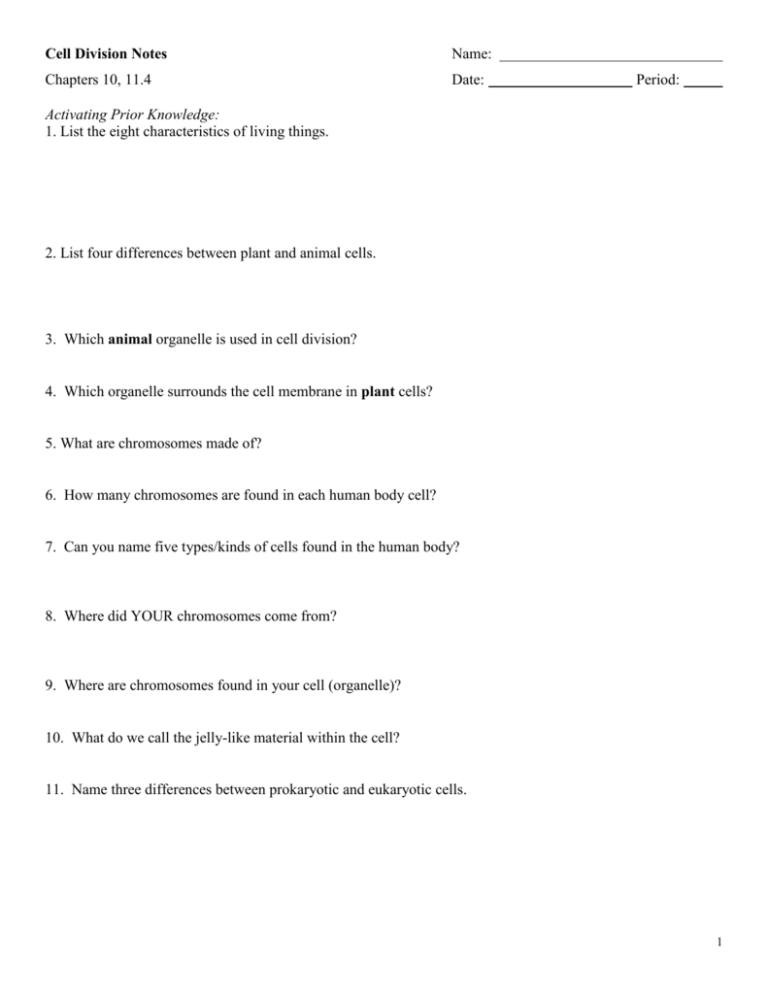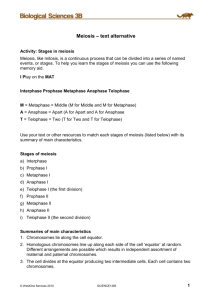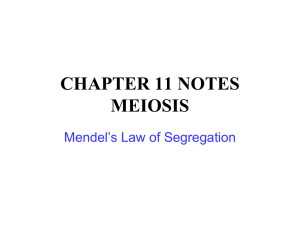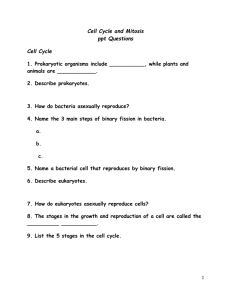Cell Division and Meiosis Notesheet
advertisement

Cell Division Notes Name: Chapters 10, 11.4 Date: Period: Activating Prior Knowledge: 1. List the eight characteristics of living things. 2. List four differences between plant and animal cells. 3. Which animal organelle is used in cell division? 4. Which organelle surrounds the cell membrane in plant cells? 5. What are chromosomes made of? 6. How many chromosomes are found in each human body cell? 7. Can you name five types/kinds of cells found in the human body? 8. Where did YOUR chromosomes come from? 9. Where are chromosomes found in your cell (organelle)? 10. What do we call the jelly-like material within the cell? 11. Name three differences between prokaryotic and eukaryotic cells. 1 Vocabulary: 1. Cell Division 2. Asexual reproduction 3. Sexual Reproduction 4. Cell Cycle 5. Chromosome 6. Histone 7. Nucleosome 8. Chromatin 9. Mitosis 10. Cytokinesis 11. Prophase 12. Centromere 13. Chromatid 14. Centriole 15. Metaphase 16. Anaphase 17. Telophase 18. Meiosis 19. Homologous chromosomes 20. Diploid 21. Haploid 22. Synapsis 23. Tetrad 24. Crossing Over 25. Independent Assortment 26. Zygote 2 Limits to Cell Size Information “Overload” and Exchanging Materials: There are two main reasons why cells do not grow indefinitely: 1. 2. Function of the cell membrane: The rate at which this exchange takes place depends on the ____________ _________ of a cell. The rate at which and are used up and are produced depends on the cell’s ____________________. The ratio of to is key to understanding why cells must divide as they grow. As the length of the sides of a cube increases, If a cell gets too , the enough to get enough of the cell is not large and in and out. Division of the Cell: Before a cell grows too large, it into two new “daughter” cells in a process called ________ ______________________. Before cell division, the cell copies all of its _________. It then divides into two “__________________” cells. Each daughter cell receives a complete set of Cell division reduces cell________________. It also results in an increased ___________________________________________________, for each daughter cell. 3 Cell Division and Reproduction Type Asexual Sexual Number of Parent(s) Outcome Genetically offspring Genetically offspring Prokaryotic and eukaryotic _______________ Example(s) celled organisms and many Most _______________ and _____________, ___________________________ cellular many __________________ celled organisms organisms Advantages Chromosomes: Every cell must its genetic information before Each begins. cell gets its own copy of that genetic information. Cells of every organism have a Prokaryotic Chromosomes Prokaryotic cells lack the . Instead, their are found in . Most prokaryotes contain a DNA molecule, or chromosome, that contains most of the cell’s genetic information. Eukaryotic Chromosomes In eukaryotic cells, chromosomes are located in the , and are made up of . Chromatin is composed of and . DNA coils around histone proteins to form . The nucleosomes interact with one another to form . 4 The Prokaryotic Cell Cycle: ________________ ___________________ is a form of reproduction during which two genetically ___________________ cells are produced. For example, reproduce by binary fission. The Eukaryotic Cell Cycle: Consists of phases: Interphase: G1 Phase S Phase G2 Phase M Phase: Cell Division Mitosis Cytokinesis 5 Important cell structures involved in MITOSIS: Chromatid – Centromere – Centrioles – Spindle – Mitosis Phase Description Illustration The ______________ phase of mitosis, the duplicated chromosome _________________ and becomes _______________________. Prophase The centrioles move ___________________________ ____________________________________________ The spindle forms and DNA strands attach at a point called their ______________________________. The ________________________ disappears and the nuclear envelope _____________________________. This is the _____________________ stage of mitosis. During metaphase, the ___________ phase of mitosis, the centromeres of the duplicated chromosomes ___________________________________________. Metaphase The ______________________ connect the centromere of each chromosome to the ______ poles of the ___________________. This is the ___________________ phase of mitosis. During anaphase, the _______ phase of mitosis, the centromeres are _______________ and the chromatids _______________ to become Anaphase _________________ chromosomes. The chromosomes separate into two groups near the _________________________________. 6 During telophase, the ___________ and ___________ phase of mitosis, the chromosomes _______________ __________________________________________ A nuclear envelope ______________ around each ________________ of chromosomes. Telophase The spindle ________________, and a ___________________ becomes visible in each ___________________ nucleus. Chromosomes __________________. Cytokinesis Animal Cells Plant Cells 7 Chromosome Number Chromosomes - - are the carriers of genes. The genes are located in on chromosomes. Homologous Chromosomes A body cell in an adult fruit fly has chromosomes. Four of the chromosomes come from its parent, and four come from its These two sets of chromosomes are parent. , meaning that Diploid Cells A cell that contains sets of homologous chromosomes is meaning “ , .” The diploid number of chromosomes is sometimes represented by the symbol For the fruit fly, the diploid number is , which can be written as 2N = . , where N represents Haploid Cells Some cells contain only a set of set of chromosomes, and therefore a . , meaning “ Such cells are The .” of sexually reproducing organisms are haploid. For fruit fly gametes, the haploid number is , which can be written as N = . Zygote = Haploid + Haploid = Synapsis and Tetrads During , the chromosomes , forming a structure called a contains , which . Crossing Over As homologous chromosomes pair up and form tetrads, they undergo a process called crossing-over. Chromatids of the chromosomes The crossed sections of the chromatids are one another. . Crossing-over is important because it produces new combinations of in the cell. Independent Assortment Genes for different traits can independently during the formation of . 8 Phases of Meiosis Meiosis is a process in which the number of through the separation of Meiosis usually involves per cell is cut in chromosomes in a distinct divisions, called By the end of meiosis II, the diploid cell becomes cell. and cells. Meiosis I Phase Description Illustration Interphase Prophase I The cells begin to , and the chromosomes __________ _____, forming a structure called a _________________, which contains _____ chromatids. As homologous chromosomes pair up and form tetrads, they undergo a process called _____________________________________. Paired ___________________ chromosomes line up Metaphase I across the __________________ of the cell. Spindle fibers pull each homologous chromosome Anaphase I _________ toward ______________ ends of the cell. When anaphase I is complete, the __________________ _________________________________________________ A __________________________________ forms Telophase I around each cluster of ___________________________. Cytokinesis follows ______________________, forming Cytokinesis _________ new cells. 9 NOTE: Meiosis I results in ___________ cells, called _________________ cells. Because each pair of homologous chromosomes was separated, neither daughter cell has _____________ ____________________________________________________________________________________. The two cells produced by meiosis I have sets of chromosomes and alleles _________________________ ____________________________________________________________________________________. Meiosis II The ________ cells produced by meiosis I now enter a ______________ meiotic division. Unlike the first division, neither cell goes through a round of entering meiosis II. Phase Prophase II Description As the cells enter prophase II, their chromosomes each consisting of ______________________ become ______________________. The chromosomes do not pair to form ________________, because the homologous pairs were already separated during meiosis I. before Illustration ________________________ line up in the Metaphase II ____________________ of each cell. The paired ___________________________ Anaphase II _________________________________. The ________________________ reforms around the ____________________. Telophase II Each of the _____ daughter cells produced in __________________ receives _______ chromatids (in this example). These ______ daughter cells now contain the Cytokinesis _______________ number (N) - just _______ chromosomes each. 10 Gamete Formation: Process Spermatogenesis Oogenesis Description and Illustration 11 Comparing Mitosis and Meiosis: Mitosis Meiosis Genetically identical daughter cells Produces gametes Metaphase Produces two cells Crossing over Polar bodies Telophase Produces diploid cells Anaphase Sperm Produces haploid cells Egg Skin cells Tetrads Prophase Produces four daughter cells Mitosis Meiosis 12









